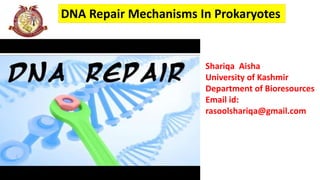
Dna repair mechanisms
- 1. DNA Repair Mechanisms In Prokaryotes Picture representing the title of the Topic Shariqa Aisha University of Kashmir Department of Bioresources Email id: rasoolshariqa@gmail.com
- 2. Introduction. DNA damage. Sources of DNA damage. DNA repair. Direct repair. Excision repair. Mismatch repair.
- 3. DNA damage is an alteration in the chemical structure of DNA, such as a break in a strand of DNA, a base missing from the backbone of DNA, or a chemically changed base in a DNA. The vast majority of DNA damage affects the primary structure of the double helix. Source of damage: Endogenous damage such as attack by reactive oxygen species produced from normal metabolic byproducts ( spontaneous mutation), especially the process of oxidative deamination. Depurination. Also includes replication errors. Exogenous damage caused by external agents such as_ ultraviolet radiation, x-rays, gamma rays, viruses etc.
- 4. DNA repair is a collection of process by which a cell identifies and corrects damage to the DNA molecules that encode its genome. The DNA repair processes is constantly active as it responds to damage in the DNA structure. Most cells posses three different categories of DNA repair systems: i) Direct repair i) Excision repair ii) Mismatch repair
- 6. Direct repair systems act directly on damaged nucleotides, converting each one back to its original structure. One common type of UV radiation mediated damages, pyrimidine dimers, are repaired by a light-dependent direct system called photoreactivation. In E. coli, the process involves the enzyme called DNA photolyase. When stimulated by light with a wavelength between 300 and 500 nm, the enzyme binds to pyrimidine dimers and converts them back to the original monomeric nucleotides.
- 7. Excision repair involves the excision of a segment of the polynucleotide containing a damaged site, followed by resynthesis of the correct nucleotide sequence by a DNA polymerase. These pathways fall into two categories: 1. Base –excision repair Base excision repair involves removal of a damaged nucleotide base, excision of a short piece of the polynucleotide and resynthesis with a DNA polymerase. It is used to repair many minor damage like alkylation and deamination resulting from exposure to mutagenic agents. Enzyme DNA glycosylase initiates the repair process.
- 8. A DNA glycosylase does not cleave phosphodiester bonds, instead cleave the N- glycosidic bonds, liberating the altered base and generating apurinic or an apyrimidinic site, both called as AP sites. The resulting AP site is then repaired by an AP endonuclease repair pathway. These enzymes introduce chain breaks by cleaving the phosphodiester bonds at AP sites. This bond cleavage initiates an excision-repair process with the help of three enzymes_ Exonuclease DNA polymerase I DNA ligase
- 10. Nucleotide excision repair This is similar to base-excision repair, but is not preceded by the removal of a damaged base and can act on more substantially damaged areas of DNA. This repair system includes the breaking of a phosphodiester bond on either side of the lesion, on the same strand, resulting in the excision of an oligonucleotide. The excision leaves a gap that is filled by repair systems, and a ligase seals the breaks.
- 11. Uvr system of excision repair in E. coli It involves the removal of relatively short, usually 12 nucleotides in length. The key enzyme is made up of three subunits, products of the uvrA, uvrB and uvrC genes, and is called ABC excinuclease. ABC excinuclease binds to DNA at the site of a lesion. First uvrA and uvrB attach to the DNA at the damaged site. UvrA recognizes the damage. Departure of uvrA allows uvrC to bind, forming uvrBC dimer which cleaves the damaged strand at the eighth phosphodiester bond on the 5’ side of the lesion and at the fourth or fifth phosphodiester bond on the 3’ side. UvrD is a helicase that helps to unwind the DNA to allow release of the single strand between the two cuts. The resulting gap is filled in by DNA polymerase I and sealed by ligase.
- 13. The mismatch repair (MMR) system can detect mismatches that occur in DNA replication. Enzyme systems involves in mismatch repair are as follows: i) Recognize mismatched base pairs. ii) Determine which base in the mismatch is the incorrect one. iii) Excise the incorrect base and carry out repair synthesis. A mismatched base pair causes a distortion in the geometry of the double helix that can be recognized by a repair enzyme system. it is important that the repair system distinguish the newly synthesized strand, which contains the incorrect nucleotide, from the parental strand, which contains the correct nucleotide.
- 14. In E. coli, the two strands are distinguished by the presence of methylated adenosine residues on the parental strand by Dam methylase. DNA methylation does not appear to be utilized by the MMR system in eukaryotes, and the mechanism of identification of the newly synthesized strand remains unclear. There are three mismatch repair systems in E. coli on the basis of the relative lengths of the unmethylated strand excised and repaired by components of the repair system. These are categorized as: Long patch Short patch Very short patch.
- 15. Long patch system in E. coli In E. coli, long patch system involves three Mut proteins, coded by the mut genes. These Mut proteins are MutH, MutL, and MutS. Recognition of the sequence GATC and of the mismatch are specialized functions pf the MutH and MutS proteins, respectively. The MutH protein cleaves the unmethylated strand on the 5’ side of the G in the GATC sequence. The combined action of DNA helicase II and exonuclease I then removes a segment of the new strand between the cleavage site and a point just beyond the mismatch. The resulting gap is filled in by DNA polymerase and the nick is sealed by DNA ligase.
- 17. Life sciences – Arihant iGenetics – A Molecular Approach by Peter J. Russell Life sciences – Pranav Kumar
